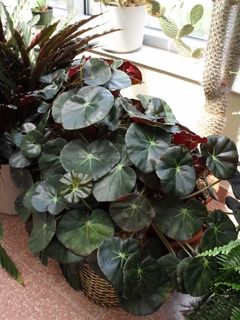
Speaking of water; youíll want to go slightly on the dry side with this one. Beefsteak Begonias grow from a rhizome which will rot if it stays too wet, not to mention the susceptibility of the delicate leaf stems. Let the potting mix dry out pretty well between waterings. You will likely notice that the leaves take on a grayish cast when the plant needs water, although watering it just before it reaches this point is ideal. If the plant goes too long without water and wilts, it will usually come right back if you water it right away.
Fertilize your Beefsteak Begonia regularly but carefully. The fertilizer salts can be harmful to the plantís roots if they are applied to strongly. Standard houseplant fertilizer will do when applied at the rate and frequency indicated on the packaging but if youíre just using what you have on hand, try to use a fertilizer with a relatively even NPK ratio (like 13-13-13) or one that has a slightly higher nitrogen content.
Beefsteak Begonias are propagated vegetatively. They can be divided, or you can do stem or leaf cuttings. If you are doing cuttings, they can be rooted in water, vermiculite or perlite. A blend of vermiculite and perlite works, too. There are many different types of cuttings you can do to obtain a new plant and all of them work pretty well. Some things that will help you have success are to take cuttings from portions of the plant that have not bloomed if you are using a portion of the stem. If you do a leaf cutting and place the petiole in the potting mix, donít press it more than an inch or so into the mix or it will take a very long time for the new shoots to emerge.


